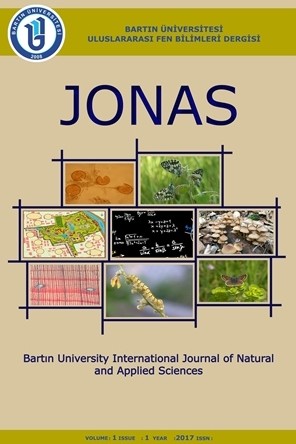SYNTHESIS AND POTENTIAL ENERGY APPLICATION OF MIL-140A AS A FILLER IN PVA MEMBRANE
SYNTHESIS AND POTENTIAL ENERGY APPLICATION OF MIL-140A AS A FILLER IN PVA MEMBRANE
Composite membrane, ion exchange membrane, MIL-140A PVA,
___
- 1. Kim, D. J., Jo, M. J., Nam, S.Y.(2015). A review of polymer– nanocomposite electrolyte membranes for fuel cell application. Journal of Industrial and Engineering Chemistry, 21, 36–52.
- 2. Li, B., Liu, J., Nie, Z., Wang, W., Reed, D., Liu, J., McGrail, P., and Sprenkle, V. (2016). Metal–Organic Frameworks as Highly Active Electrocatalysts for High-Energy Density, Aqueous Zinc-Polyiodide Redox Flow Batteries, Nano Lett. 16, 4335–4340.
- 3. Liang W., D’Alessandro, D. M. (2013). Microwave-assisted solvothermal synthesis of zirconium oxide based metal–organic frameworks. Chem. Commun., 49, 3706.
- 4. Liu, Q., Li, Z., Wang, D., Li, Z., Peng, X., Liu, C., Zheng, P. (2020). Metal Organic Frameworks Modified Proton Exchange Membranes for Fuel Cells, Front Chem. 8: 694.
- 5. Morozana, A., Jaouen, F. (2012). Metal organic frameworks for electrochemical applications. Energy Environ. Sci.,5, 9269-9290.
- 6. Patel, H. A., N.,Mansor, S., Gadipelli, Dan J. L. Bretand Zhengxiao Guo. (2016). Superacidity in Nafion/MOF Hybrid Membranes Retains Water at Low Humidity to Enhance Proton Conduction for Fuel Cells. ACS Appl. Mater. Interfaces, 45, 30687–30691.
- 7. Prakash, M., Jobic, H. Ramsahye, N., Nouar, F., Damasceno Borges, D., Serre, C., Maurin, G.(2015) Diffusion of H2, CO2, and Their Mixtures in the Porous Zirconium Based Metal–Organic Framework MIL-140A(Zr): Combination of Quasi-Elastic Neutron Scattering Measurements and Molecular Dynamics Simulations. The Journal of Physical Chemistry C, 119(42), DOI:10.1021/acs.jpcc.5b07253
- 8. Sahin A. (2018). The development of Speek/Pva/Teos blend membrane for proton exchange membrane fuel cells. Electrochimica Acta, 271, 127-136.
- 9. Smitha, B., Sridhar S., Khan, A. A. (2005). Proton Conducting Composite Membranes from Polysulfone and Heteropolyacid for Fuel Cell Applications. J Polym Sci Part B: Polym Phys 43, 1538–1547.
- 10. Soares, V., C., Damasceno Borges, D., Wiersum, A., Martineau, C., Nouar, F., Llewellyn, P. L., Ramsahye, N. A., Serre, C., Maurin, G., Leitão A. A. (2016). Adsorption of Small Molecules in the Porous Zirconium-Based Metal Organic Framework MIL-140A (Zr): A Joint Computational-Experimental Approach. J. Phys. Chem. C 120(13), 7192–7200.
- 11. Sui, X., Ding, H., Leong, Z. Y. C. F., Goh, K., Lia, W., Yang, N., M.D’Alessandro, D., Chen, Y. (2019). The roles of metal-organic frameworks in modulating water permeability of graphene oxide-based carbon membranes. Carbon, 148, 277-289.
- 12. Trindade, L., Borba K.M.N., Zanchet, L., D. W. Lima, A. B. Trench, Fernando Rey, Diaz, U., Longo, E., Bernardo-Gusmão K., Martini, E.M.A (2019). SPEEK-based proton exchange membranes modified with MOF-encapsulated ionic liquid.Materials Chemistry and Physics, 236, 121792, https://doi.org/10.1016/j.matchemphys.2019.121792.
- 13. Voorde, B. V., Hezinová, M., Lannoeye, J., Vandekerkhove, A., Marszalek, B., Gil, B., Beurroies, I., Petr N. Dirk De Vos. (2015). Adsorptive desulfurization with CPO-27/MOF-74: an experimental and computational investigation. Phys. Chem. Chem. Phys., 17, 10759-10766.
- 14. Wang, 1. Y. Chen, K. S., Mishler, J. Cho, S. C. Adroher X. C. (2011). A review of polymer electrolyte membrane fuel cells: Technology, applications, and needs on fundamental research. Applied Energy, 88, 981–1007.
- 15. Wong, C. Y., Wong, W. Y., Loh, K. S., Daud, W. R. W., Lim, K. L. Khalid, M., Walvekar, R. (2020). Development of Poly(Vinyl Alcohol)-Based Polymers as Proton Exchange Membranes and Challenges in Fuel Cell Application: A Review, Polymer Reviews, 60:1, 171-202.
- 16. Yahaya, N.Z.S., Paiman, S. H., Abdullah, N., Mahpoz, N. M., Raffi, A. A., Rahman, M. A., Abas, K. H., Aziz, A. A., Othman, M. H. D., Jaafar, J. (2020). Synthesis and characterizations of MIL-140B-Al2O3/YSZ ceramic membrane using solvothermal method for seawater desalination, Journal of the Australian Ceramic Society, 56, 291–300.
- 17. Zhiwei, W., Hao, Z., Qiang, C. (2019). Preparation and characterization of PVA proton exchange membranes containing phosphonic acid groups for direct methanol fuel cell applications. J Polym Res., 26, 200 https://doi.org/10.1007/s10965-019-1855-9
- Yayın Aralığı: Yılda 2 Sayı
- Başlangıç: 2017
- Yayıncı: Bartın Üniversitesi
YENİ SENTEZLENEN İKİ SÜLFONAMİD BİLEŞİĞİNİN DROSOPHILA MELANOGASTER’DE TERATOJENİK DEĞERLENDİRİLMESİ
A STUDY OF PAVEMENT MATERIAL USED ON MAIN TRANSPORTATION ROUTES OF TRABZON CITY
SYNTHESIS AND POTENTIAL ENERGY APPLICATION OF MIL-140A AS A FILLER IN PVA MEMBRANE
POLİLAKTİK ASİT TEMELLİ MEMBRANIN MORFOLOJİSİNİN DESALİNASYON PERFORMANSINA ETKİSİ
Betül KARAKOCA, Filiz UĞUR NİGİZ
ÇAMLICA CAMİİ’NİN EVRENSEL TASARIM KAPSAMINDA DEĞERLENDİRİLMESİ
Nur Sümeyye YALÇIN KOÇAK, Şahika ÖZDEMİR
KENEVİR LİFLERİNİN ELDESİ, ÖZELLİKLERİ VE KOMPOZİT UYGULAMA ALANLARI
